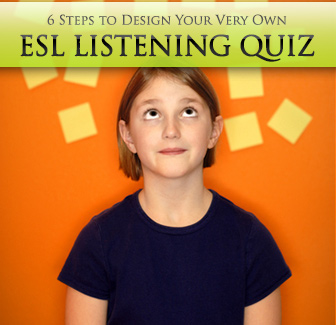7 Great Places to Look for ESL Listening Material


So, the ESL teacher decides to give the class some extra fun listening practice. There are some really great websites that offer video and audio geared at English learners, and they even come with vocabulary lists and quizzes to test students’ listening comprehension. Sweet!
But you want to work with real audio like a CNN news report, a podcast or a TV series. And those don’t come with ready-to-use quizzes. Don’t let that discourage you from using real audio for listening practice. You can create your own listening quiz in six simple steps and here’s how:

The first thing you’ll have to decide is which source of real audio you’ll use. Will it be a TV commercial, weather report or movie trailer? Base your decision on the course work. Did you recently teach words related to the weather? Then the weather report is a good choice. Did your students just learn words related to health? Then you should go for the news report about a recent outbreak of the flu. Are there grammar points you need to review, like a verb tense? Choose an audio file that features the tense you have to review. A report about what will happen to the environment if we don’t implement changes is a great way to review the first conditional. Review and sharpen listening skills at the same time.
What about the audio format? Will you play a cassette or CD in class, or show them a video? Will you play a video online? Or will you send them a link to the listening assignment for homework? A good rule of thumb is to give students variety, so if all you’ve been doing is listening to CDs, give them an online video to watch. Change it up!
The purpose of the listening quiz will be connected to Step 1 and the reason you chose a particular audio file. What is it? Is it to review words related to shopping? Is it to review a verb tense, like the Simple Past? Or is it to hone a specific listening skill, like listening for gist or listening for specifics?
Will you type out the quiz on a Word document and print it out for students to use as they listen? Or will you design a quiz online? Your decision should be based partly on when and where your students will take the quiz. If you’re planning on giving them the quiz in class, then the printed version is the easiest way to go. But if you’re giving them the quiz for homework, they can easily work online with the links you give them. Some great quiz makers are ProProfs, Quizlet and AlltheTests.com.
Will it be True or False, or multiple choice? Will they have to fill in the blanks? Again, your choice should depend on what you want to test them on. If you’re using the listening exercise to help them review the Simple Present, maybe they should have blanks that they must fill with the right verb. If they are listening for specific information, a multiple choice exercise will do the trick.
Before you can start designing your quiz, you’ll have to listen to the audio/video carefully – several times. Make a note of key vocabulary and questions you could possible ask, as well as the things you’ll test them on. You may have to choose another audio file altogether if you see this one in particular does not fit your purposes after all.
If you decide to simply type up a Word document, it shouldn’t take you too long, as you’ve already decided what type of task you’ll be focusing on in the previous steps. You’ll also have all the information you’ll need from having listened to the audio. If you decide to use an online quiz maker, the software should guide you through the steps.

Each type of quiz has its own particularity, but they all have one thing in common: they are tricky. For instance, for True or False statements, you can make the false sentence very similar to the true statement except for one little detail. This is a great opportunity to practice things like minimal pairs or homophones.
The neighbor is giving away three puppies. (False. He’s giving away free puppies.)
You can do the same with a multiple choice quiz:
The neighbor is giving away:
Make your listening quiz challenging!
It doesn’t matter if you create a basic Word document or an online quiz with all the bells and whistles. What matters is that you create a quiz that is tailored to your students’ listening needs.
Have you ever used an online quiz maker? Share below!